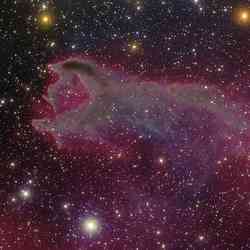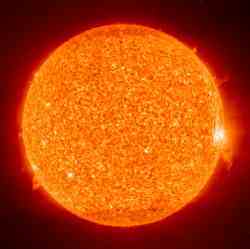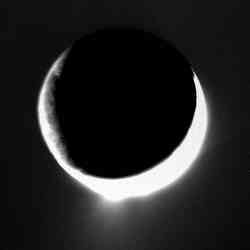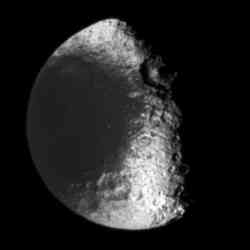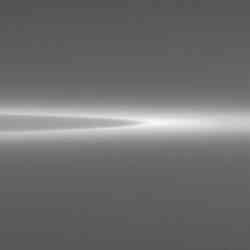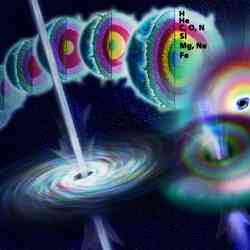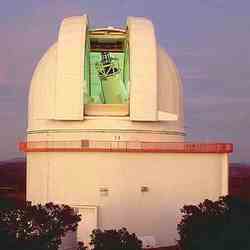
Harlan J. Smith Telescope. Image credit: Marty Harris/McDonald Observatory. Click to enlarge
An international group of astronomers has used the Hubble Space Telescope to determine the origin of an unusual class of objects called extreme helium stars. These objects are formed when two white dwarf stars merge together. Since they were first discovered more than 60 years ago, less than two dozen have found. They contain almost no hydrogen, and are dominated by helium and other heavier elements. When two white dwarf stars merge together, the resulting star swells up to become a supergiant star rich in helium.
An international group of astronomers including Dr. David L. Lambert, director of The University of Texas at Austin McDonald Observatory, has used Hubble Space Telescope to determine the origin of a very unusual and rare type of star. The group’s studies indicate that the so-called “extreme helium stars” are formed by the merger of two white dwarf stars. The work has been published in the February 10 issue of The Astrophysical Journal.
The team was led by Dr. Gajendra Pandey of the Indian Institute of Astrophysics (IIA) in Bangalore, and also includes Dr. C. Simon Jeffery of Armagh Observatory in Northern Ireland, and Professor N. Kameswara Rao, also of IIA.
“It’s taken more than 60 years after the first discovery at McDonald to get some idea of how these formed,” Rao said. He has been studying these types of stars for more than 30 years. “We are now getting a consistent picture.”
The nature of the first extreme helium star, HD 124448, was discovered at McDonald Observatory in 1942 by Daniel M. Popper of The University of Chicago. Since then, fewer than two dozen of these stars have been identified. They are supergiant stars – less massive than the Sun but many times larger and hotter – and remarkable for their strange compositions. They contain almost no hydrogen, the most abundant chemical element in the universe, and the most basic component of all stars. Instead, they are dominated by helium, with significant amounts of carbon, nitrogen, and oxygen, and traces of all other stable elements.
The origin of extreme helium stars cannot be traced back to formation in a cloud of helium gas, since no such clouds exist in our Milky Way galaxy. Nuclear reactions in a star like the Sun convert hydrogen to helium to provide sunlight or starlight. Since the helium is confined the hot core of a star, the star must lose vast amounts of gas before the helium is at the star’s surface – and thus detectable by telescopes. No known mechanism inside the star can drive off the overlying layers to expose the helium.
Two decades ago, astronomers Ronald Webbink and Icko Iben of the University of Illinois introduced the theory that extreme helium stars formed from the merger of two white dwarfs.
White dwarfs are the end product of the evolution of stars like the Sun. They don’t contain much hydrogen. Some are rich in helium, and others in carbon and oxygen. A pair of white dwarfs can result from the evolution of a normal binary star (two normal stars in orbit around each other).
Webbink and Iben supposed that, in some cases, one star in the binary may evolve as a helium-rich white dwarf, and the other as a carbon-oxygen-rich white dwarf. Over billions of years of orbiting each other, the two stars lose energy and move steadily closer to each other. Eventually, the helium white dwarf is consumed by the more massive carbon-oxygen white dwarf. The resultant single star swells up to become a helium-rich supergiant star.
To test this theory, astronomers needed to uncover the exact chemical composition of extreme helium stars. This is what Pandey, Lambert, and their colleagues set out to do. They obtained crucial observations with NASA’s Hubble Space Telescope, and made supporting observations from the 2.7-meter Harlan J. Smith Telescope at McDonald Observatory and the 2.3-meter Vainu Bappu Telescope in India.
“As an aside,” Lambert said, “it’s interesting to note that the namesakes of these two telescopes, Harlan J. Smith and Vainu Bappu, were the very best of friends in graduate school at Harvard.” Later, Smith served as director of McDonald Observatory from 1963 to 1989. Vainu Bappu founded the Indian Institute of Astrophysics. “Today, with collaborations like this project,” Lambert said, “we’re maintaining the important international and personal ties that astronomy thrives upon.”
The group made detailed studies of the ultraviolet light coming from seven extreme helium stars with Hubble Space Telescope’s STIS instrument (the Space Telescope Imaging Spectrograph) and of the optical light from the telescopes in Texas and India. This data provided them with the specific amounts of at least two dozen different chemical elements present in each star they studied.
According to Rao, it is the advance in technology of being able to observe the spectra of these stars in ultraviolet light with Hubble that made this breakthrough study possible more than 60 years after extreme helium stars were discovered.
The Hubble results match up well with predicted compositions from models of the composition of a star formed through the merger of two white dwarf stars in which the helium-core white dwarf is torn apart, and forms a thick disk around the carbon-oxygen white dwarf. Then, in a process taking only a few minutes, the disk is gravitationally pulled into the carbon-oxygen white dwarf.
What happens next depends of the mass of the new, resulting star. If it is above a certain mass, called the Chandrasekar limit, it will explode (specifically, it will explode as a Type Ia supernova). However, if the mass is below this limit, the new merged star will balloon up into a supergiant, eventually becoming an extreme helium star.
Pandey, Lambert, Jeffery, and Rao plan to continue their research on extreme helium stars, using both the Smith and Hobby-Eberly Telescopes at McDonald Observatory. They hope to identify more extreme helium stars, and discover even more chemical elements in these stars.
This research was supported by grants from the Robert A. Welch Foundation of Houston, Texas and the Space Telescope Science Institute in Baltimore, Maryland.
Original Source: University of Texas at Austin

